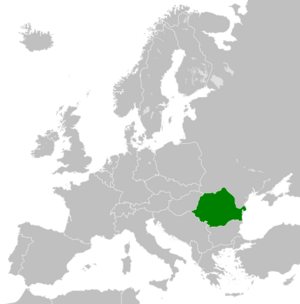Socialist Republic of Romania
The Socialist Republic of Romania was a Marxist-Leninist one-party communist state that existed officially in Romania from 1947 to 1989. From 1947 to 1965, the state was known as the Romanian People's Republic. The country was in the Warsaw Pact and had a dominant role for the Romanian Communist Party enshrined in its constitutions.
Economy
Living standards
In the 1960s and '70s life was not particularly bad,[clarification needed] though the '80s were a whole different story as Ceaușescu sought to quickly pay off Western loans by imposing harsh austerity measures, coupled with efforts to raise the birth rate by restricting abortion. To top it all off there was also the construction of a giant building, the Palace of the Parliament, which was very costly (Ceaușescu insisted that all of its components be sourced entirely from Romania), which also required the demolition of a lot of buildings surrounding it. By 1989 there was mass disillusionment with the RCP's ideology and resentment against the privations that Romanians had to endure, with this sentiment reaching many elements of the army and security services, which would later arrest and execute Ceaușescu following protests.
Despite economic conditions worsening, Romanians were not starving. Anthony Daniels, an author who visited the country a few months before Ceaușescu's overthrow, writes in Utopias Everywhere about Romanian living standards:
Often [in hospitals] there were two patients to a bed, drugs were unavailable and equipment ancient or broken down. Births were not registered until six months or later, an administrative method of keeping the infant mortality rate under control. Bribes were essential to obtain treatment, officially free. . . Rags and scraps were often used for dressings in the absence of bandages and ambulances sometimes failed to attend cases for lack of fuel.
My first car [in Romania] was red (until I had to change it for a light blue one when I ran out of petrol because the contents of the tank had been siphoned off and the fuel gauge interfered with in the hotel car park).
The first man whom I contacted, an economist, had just spent four hour queuing for eggs (and failed to obtain them). . . A Swiss friend of mine once saw people in Bucharest fighting over potatoes. . . . there was such a shortage of domestic gas that, during winter, people had to cook after midnight, when the pressure was a little higher. Even so, it took half an hour to heat sufficient water for a cup of tea. . . during winter, when there was not an outright power cut, rooms were allowed not more than one 40 watt bulb each. . .
There were shortages of almost everything (even in my privileged capacity of tourist I was not to eat fresh vegetables once in Romania). There was a black market in books - not in forbidden ones alone, but in all kinds. A novel might cost half a month's salary.
Everywhere one saw the harvest stacked in the fields, but storage and transport were inadequate, and half of what was produced would surely have rotted there. (This is one of the reasons why figures for production can rise relentlessly in countries like Romania, yet nothing ever appear in the shop.)
Despite Ceaușescu being a lousy leader, however, the nation was still socialist, as the means of production were socialized and a capitalist class was non-existent.


